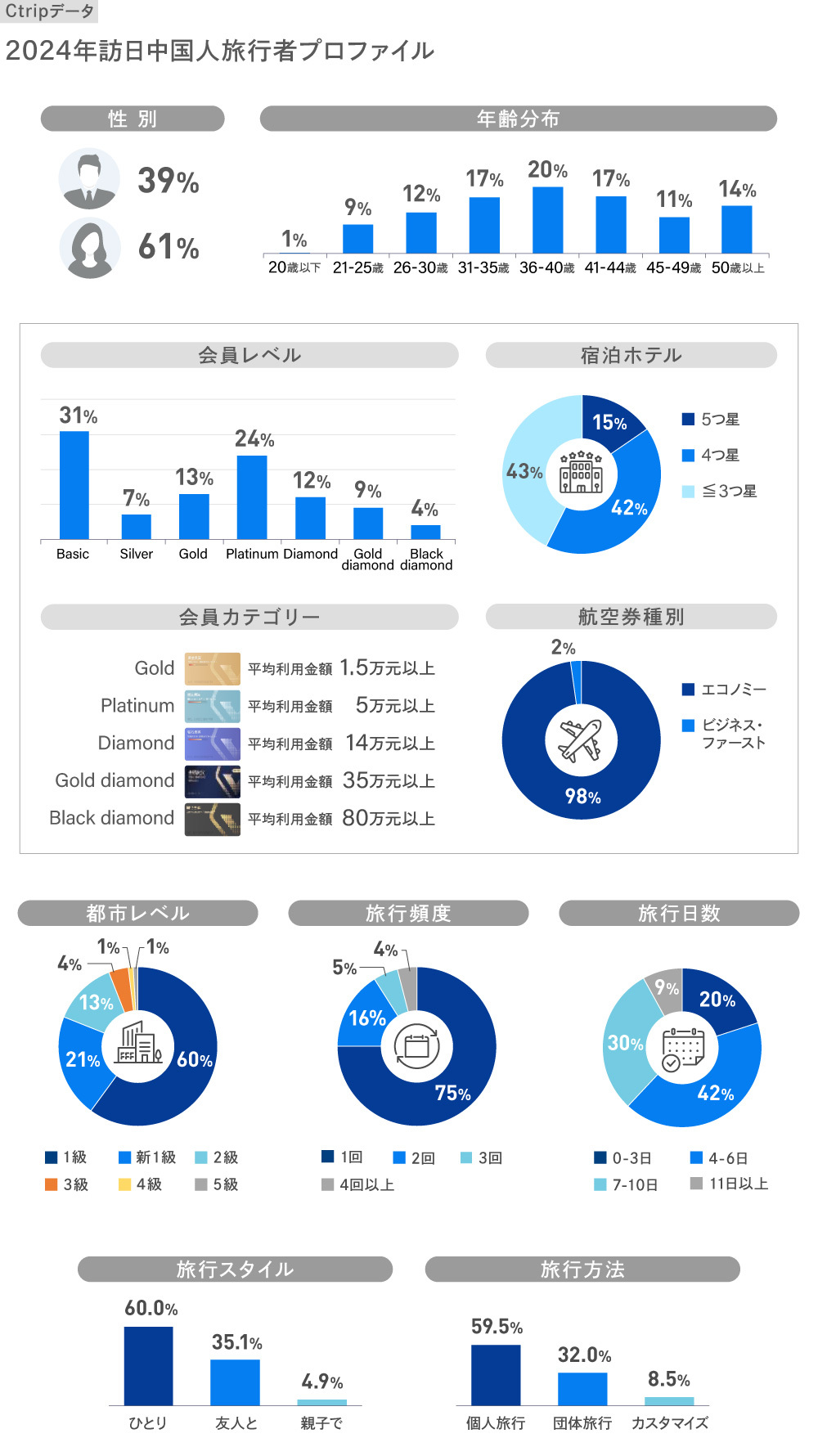This series delves deep into insights using comprehensive data to uncover the true nature of Chinese travelers visiting Japan. The previous installment reviewed trends in Chinese outbound travel using publicly available data from sources like the Chinese government, organizing foundational information such as the recovery of traveler numbers and shifts in demand.
This installment reveals key points for practical inbound marketing—such as travel purposes, purchasing tendencies, and consumption patterns—based on changes observed in our proprietary online survey of Chinese visitors to Japan. The survey was conducted in December 2023 and March 2025 with the cooperation of Ctrip, China's largest online travel agency and a Dentsu Inc. partner.
2024 Chinese Visitor Numbers to Japan Recover
According to Japan National Tourism Organization (JNTO) data, the number of Chinese visitors to Japan in 2024 reached 6,981,200, recovering to approximately 73% of 2019 levels. While the recovery rate was low in the first half of the year, it has accelerated in the second half. Data from Ctrip, China's largest online travel agency and Dentsu Inc.'s partner for inbound business targeting Chinese visitors to Japan, indicates that the number of Chinese visitors to Japan in 2025 is expected to increase by approximately 20% compared to 2024. Consequently, the number of Chinese visitors to Japan in 2025 is projected to approach pre-pandemic levels.
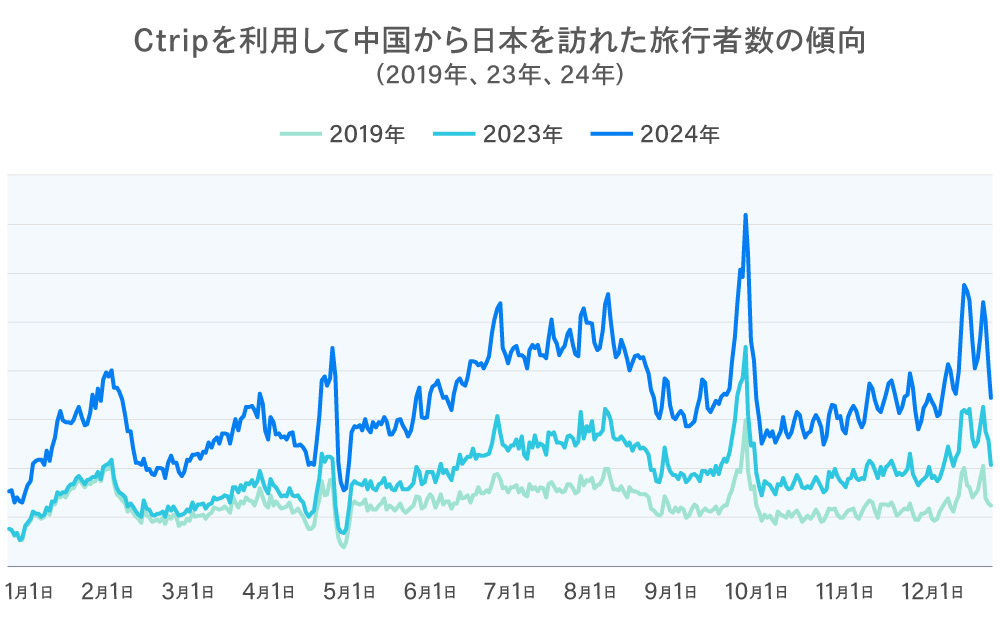
Travel Behavior of Chinese Tourists to Japan Revealed by Ctrip Data
With Ctrip's cooperation, we also obtained data on the trends of Chinese travelers who visited Japan using Ctrip in 2024. This revealed the following characteristics:
• Chinese travelers visiting Japan via Ctrip reached record highs throughout the entire period when comparing pre-pandemic 2019 with the immediate post-pandemic period of 2023.
• The male-to-female ratio was 4:6, with women outnumbering men.
• The largest age group was those in their late 30s, followed by those in their early 30s and early 40s.
• Residence cities are primarily large cities (Tier 1, New Tier 1, and Tier 2*).
• While most visit Japan once per year, a significant number visit two or more times.
• Travel duration of 4 to 6 days accounts for over 40%. Meanwhile, 20% visit for short stays of 3 days or less.
• Regarding travel style, independent travel exceeds half, while group tours show a declining trend.
※In China, cities are informally categorized into six tiers—from Tier 1 (Beijing, Shanghai, etc.) and New Tier 1 (Qingdao, Chengdu, etc.) to Tier 5—based on population, economic level, and other factors. While not a legally defined administrative classification, the "City Attractiveness Ranking" published annually by China's major economic magazine "First Financial Daily" and its affiliated think tank serves as the standard, with the list changing slightly each year.
Reference site: China Media Group "First Financial Releases '2025 New Tier-1 Cities Attractiveness Ranking,' Refreshing the Past and Rediscovering"
https://www.smg.cn/review/202505/0166469.html
Additionally, regarding travel to Japan, Ctrip's analysis of booking data reveals the following trends regarding when visa applications, airline tickets, accommodation reservations, and theme park tickets are typically arranged relative to the visit date:
• Visa arrangements: Over half are made more than one month before departure.
• Airfare booking: The vast majority complete purchases about two weeks before departure.
• Hotel reservations and theme park tickets: Increasingly booked later than airline tickets, with a significant number arranging tickets less than one week before departure.
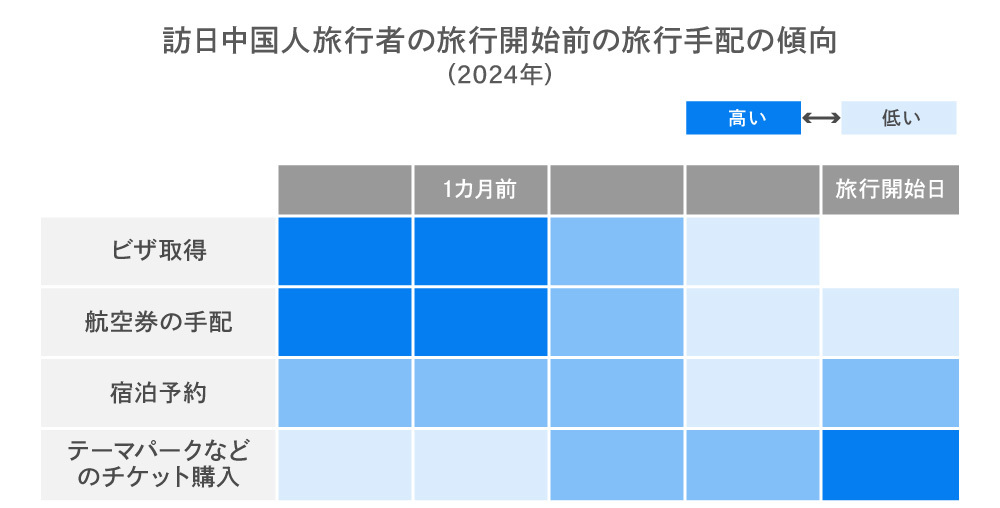
Source: Ctrip data
Trends Among Chinese Visitors to Japan Revealed by Dentsu Inc.'s Original Survey
Dentsu Inc. conducted an online survey in March 2025 targeting Chinese travelers who visited Japan during the year-end/New Year period from 2024 to 2025 and the 2025 Spring Festival period using Ctrip. This survey follows a first one conducted in late 2023, immediately after the pandemic subsided and Chinese outbound travel resumed.
The survey aimed to identify the latest trends in the purposes and behaviors of Chinese tourists visiting Japan. It also sought to clarify their travel objectives, perceptions, and expectations by comparing the period immediately after the pandemic with the current situation where the number of Chinese visitors to Japan has recovered.
[Survey Overview]
Survey Period: Mid- to late March 2025
Survey Participants: Users who booked airline tickets or hotel stays via Ctrip during the year-end/New Year period spanning 2024-2025 and during the 2025 Spring Festival period
Survey Method: SMS invitation sent to participants, followed by online survey via website
Valid Responses: 449
Next, we will delve into items where significant differences in awareness and behavior emerged between the surveys conducted at the end of 2023 and in March 2025.
Key finding 1: Changes in channels used for travel planning and during travel → SNS becomes crucial
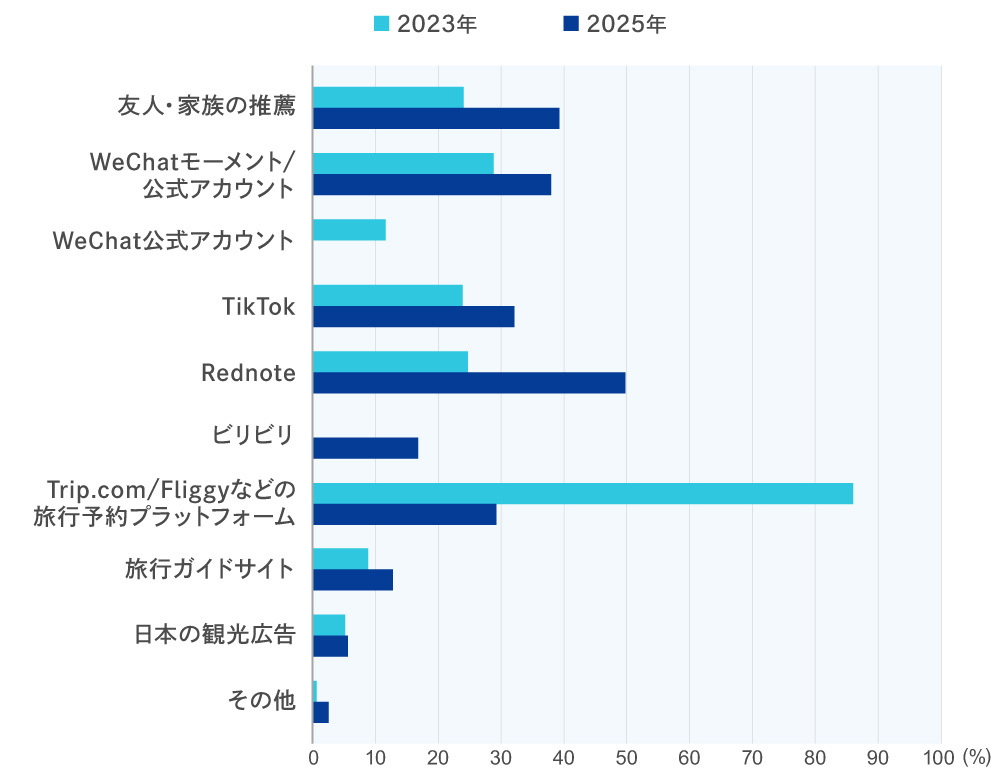
Due to travel restrictions during the COVID-19 pandemic, information gathering primarily occurred on travel sites like Ctrip in 2023. However, over the past two years, as many Chinese travelers resumed overseas trips, they began actively posting and sharing their experiences on SNS and other platforms. Additionally, the style of overseas travel among Chinese tourists has shifted from group tours to independent travel, where individuals plan and execute their own itineraries. Consequently, the importance of information gathering channels such as direct personal connections and word-of-mouth recommendations via SNS has increased significantly.
Key Point 2 from the Survey: Changes in Shopping During Japan Travel
1) Timing of purchase planning: Closer to departure
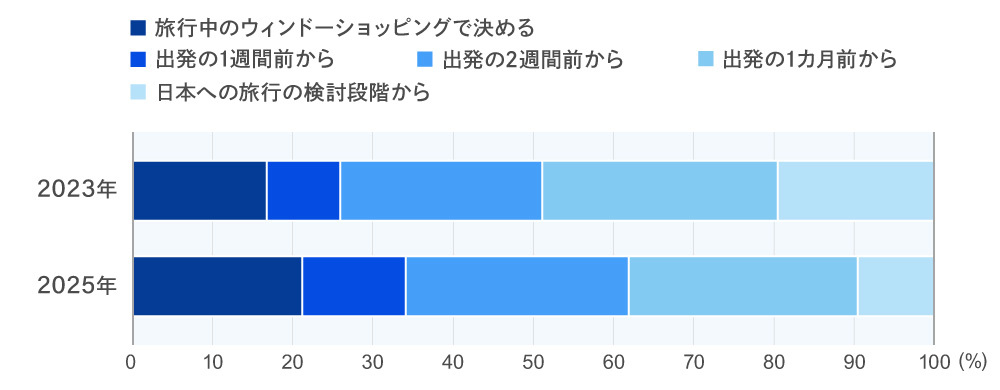
While the purpose of traveling to Japan showed no significant change from the previous survey, shifts have occurred in where and what tourists purchase during their trips. The proportion of travelers who "decide what to buy systematically before even planning their trip to Japan" has decreased, while the proportion who "begin considering purchases 1-2 weeks before departure" has increased. Furthermore, the style of "deciding what to buy while enjoying window shopping during the trip" is also growing, rather than planning purchases in advance.
2) Shopping Locations: High Purchase Rate at Drugstores
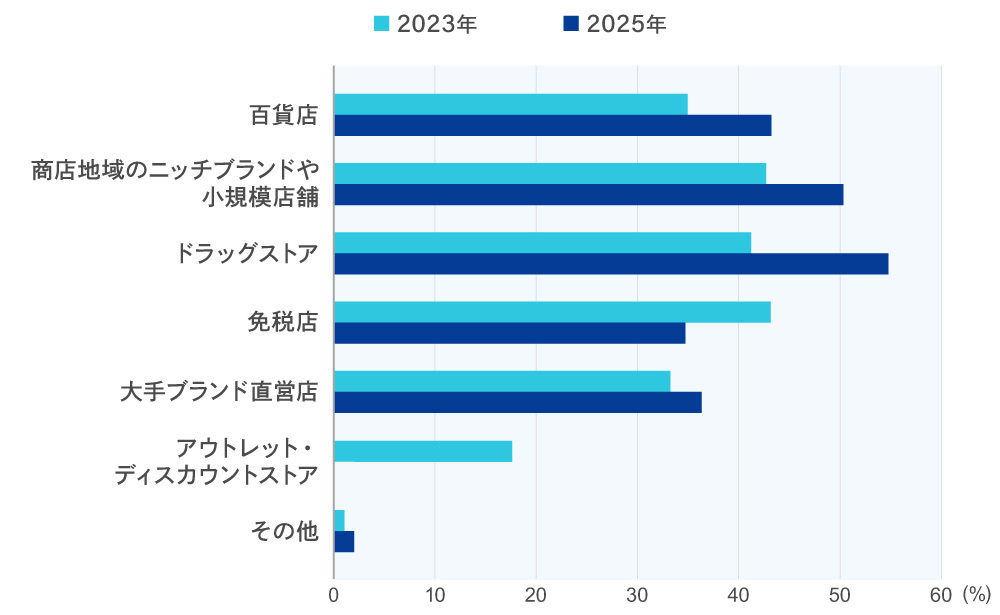
While most shopping channels have seen growth, drugstores have experienced particularly significant growth. Department stores and smaller shops like niche brands follow.
3) Planned budget for spending during travel: Increasing trend
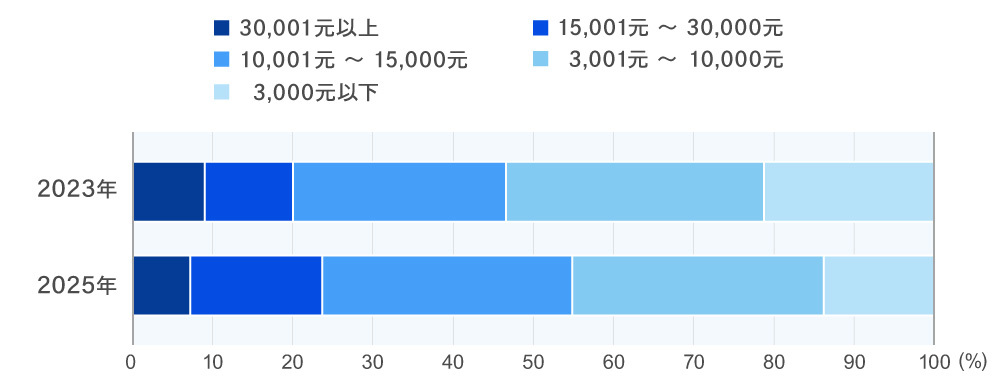
Reference: 1 CNY = 20.17 JPY (as of June 27, 2025, Mizuho Bank mid-market rate)
Expenditure amounts have increased compared to the previous survey. While there are news reports about concerns regarding the Chinese economy, it is also possible that at the time of the survey, the Renminbi remained relatively strong against the Japanese Yen. Regarding planned purchase categories, "Cosmetics," which topped the list in the previous survey, has now ceded the top spot to "Fashion (Apparel, Shoes, Accessories)."
4) Products Considering Purchasing During Travel: Fashion & Pharmaceuticals Increase

Regarding planned purchase categories, "Makeup/Skincare Products, Beauty Devices"—which topped the list in the previous survey—ceded its top position to "Fashion (Apparel, Shoes, Accessories)".
Regarding the rate of increase/decrease in intended purchase categories, the growth rate for the "Medicine" category is particularly notable. "Makeup/Skincare Products, Beauty Devices" decreased compared to the previous survey, while the growth rates for "Anime and Manga Goods" and "Home Appliances" were lower than others. For these categories, it is likely that many companies have entered the Chinese market in recent years, making them more readily available domestically in China. This may be leading consumers to reassess the necessity of purchasing them in Japan.
For those interested in further details of this report, please contact us at the address below.
Contact: dentsu-gbc@dentsu.co.jp
Next time, we will explore the characteristics of Chinese visitors to Japan through a preliminary analysis using Dentsu Inc. China's digital audience data platform "Merkury," which reveals personas of Chinese inbound travelers. We will uncover insights that can be utilized in the communication strategies and implementation of companies and local governments.







